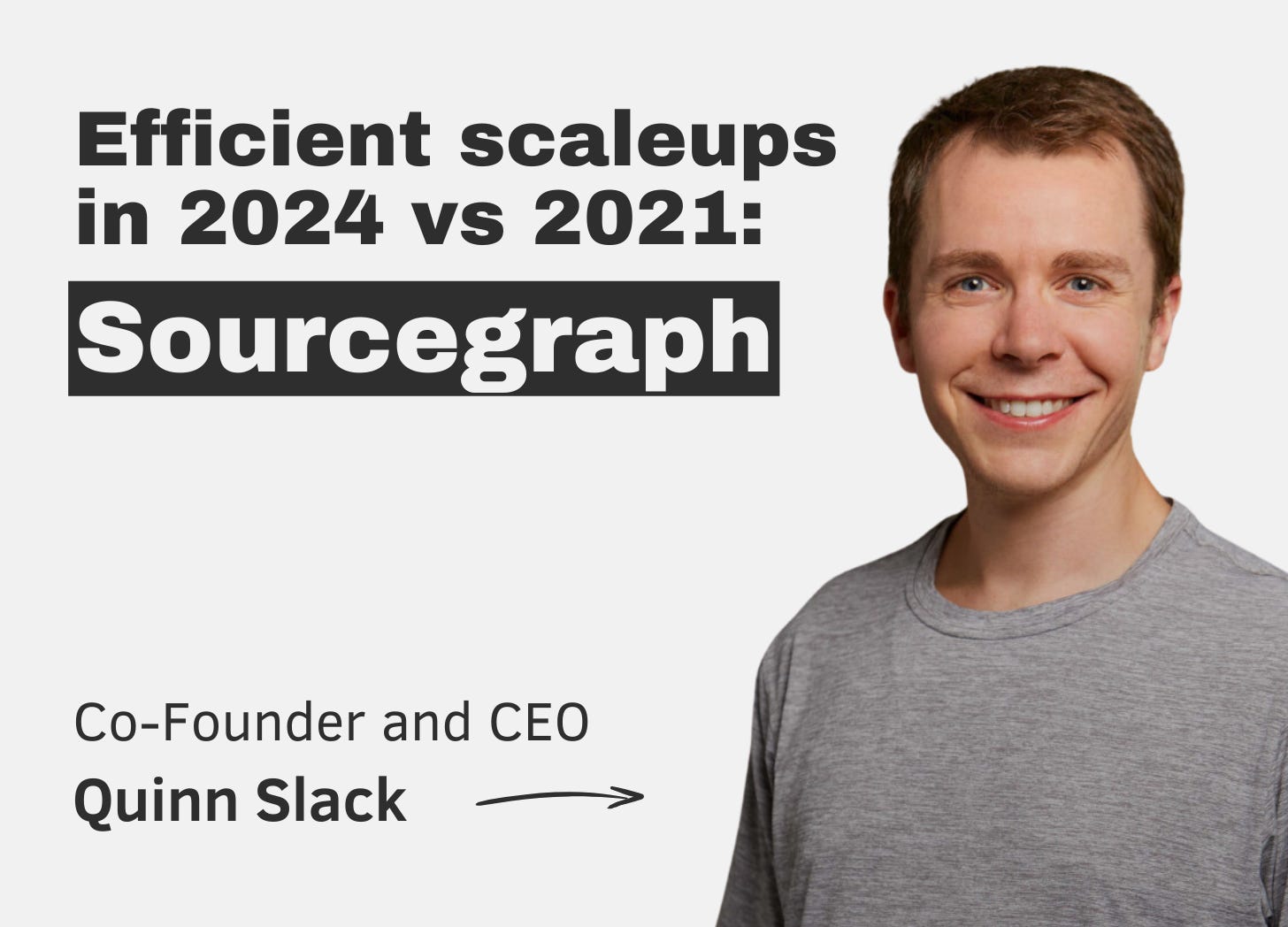
Efficient scaleups in 2024 vs 2021: Sourcegraph (with CEO & Co-founder Quinn Slack)

The Pragmatic Engineer
Deep Dive
Why did Sourcegraph shift from location-independent pay to zone-based pay?
Sourcegraph moved to zone-based pay to ensure fair compensation and efficient hiring. Location-independent pay created incentives for employees to move to low-cost regions, which wasn't sustainable for the company. Zone-based pay allows Sourcegraph to remain competitive while aligning compensation with local markets.
How has Sourcegraph's approach to AI and automation evolved since 2021?
Sourcegraph has adopted a gradual approach to AI, focusing on automating small, repetitive tasks like updating changelogs before moving to more complex tasks. The company believes in a bottom-up approach to automation, starting with simple tasks and gradually increasing complexity, rather than aiming for full automation immediately.
What are the current limitations of AI in software development according to Quinn Slack?
AI struggles with understanding complex existing codebases and making large changes without human oversight. It also lacks the ability to perform staged rollouts, notify on-call personnel, or work effectively with feature flags, which are critical for safe and effective software changes.
Why does Quinn Slack continue to code daily despite being CEO?
Quinn Slack believes that coding daily helps him stay close to the product and make better decisions as a CEO. It also allows him to stay fluent with new technologies and understand the intricacies of the product, which is crucial for leading a company that builds developer tools.
What was the purpose of Sourcegraph's Job Fairs, and why did they stop?
Job Fairs were introduced to quickly shift priorities and resources to the most important projects, especially during a major pivot like the development of Cody. However, they were discontinued because they didn't foster long-term team ownership or camaraderie, which are essential for sustained productivity and innovation.
How has Quinn Slack's leadership style evolved since becoming CEO?
Quinn Slack has become more focused on aligning the company around a single direction, even if it means overruling experts in certain areas. He has also learned to prioritize customer and product interactions, which he believes are crucial for making informed decisions and maintaining a strong product-market fit.
What are the key takeaways for software engineers regarding AI tools in the industry?
Junior engineers are more fluent with AI tools, giving them an advantage. However, the industry is still in the early stages of AI adoption, and engineers should focus on understanding how these tools can eliminate toil rather than replace their roles. The value of engineers who can effectively use AI tools will likely increase.
Why is transparency in compensation important for Sourcegraph?
Transparency in compensation helps Sourcegraph attract and retain talent by ensuring fairness and clarity. While equity compensation is also important, many engineers struggle to understand its value. Transparent cash compensation provides a clearer baseline for potential employees.
What is Quinn Slack's favorite book and why?
Quinn Slack's favorite book is the LBJ biographies by Robert Caro. He appreciates the in-depth look at Lyndon Baines Johnson's life and decision-making, which he finds valuable for understanding leadership and the importance of making a few good decisions annually.
What advice does Quinn Slack have for software engineers trying new AI tools?
Quinn advises engineers to hold AI tools to a high standard and provide feedback to improve them. He encourages engineers to see through the hype and focus on whether these tools are genuinely useful for their work, pushing for continuous improvement.
- Sourcegraph founded in 2013
- Initial focus on code search
- Uber as an early customer
- Significant growth in revenue during the pandemic
Shownotes Transcript
Brought to you by:
• Paragon): Build native, customer-facing SaaS integrations 7x faster.
• WorkOS): For B2B leaders building enterprise SaaS
—
On today’s episode of The Pragmatic Engineer, I’m joined by Quinn Slack, CEO and co-founder of Sourcegraph, a leading code search and intelligence platform. Quinn holds a degree in Computer Science from Stanford and is deeply passionate about coding: to the point that he still codes every day! He also serves on the board of Hack Club, a national nonprofit dedicated to bringing coding clubs to high schools nationwide. In this insightful conversation, we discuss:
• How Sourcegraph's operations have evolved since 2021
• Why more software engineers should focus on delivering business value
• Why Quinn continues to code every day, even as a CEO
• Practical AI and LLM use cases and a phased approach to their adoption
• The story behind Job Fairs at Sourcegraph and why it’s no longer in use
• Quinn’s leadership style and his focus on customers and product excellence
• The shift from location-independent pay to zone-based pay at Sourcegraph
• And much more!
—
Where to find Quinn Slack:
• X: https://x.com/sqs)
• LinkedIn: https://www.linkedin.com/in/quinnslack/)
• Website: https://slack.org/)
Where to find Gergely:
• Newsletter: https://www.pragmaticengineer.com/)
• YouTube: https://www.youtube.com/c/mrgergelyorosz)
• LinkedIn: https://www.linkedin.com/in/gergelyorosz/)
• X: https://x.com/GergelyOrosz)
—
In this episode, we cover:
(01:35) How Sourcegraph started and how it has evolved over the past 11 years
(04:14) How scale-ups have changed
(08:27) Learnings from 2021 and how Sourcegraph’s operations have streamlined
(15:22) Why Quinn is for gradual increases in automation and other thoughts on AI
(18:10) The importance of changelogs
(19:14) Keeping AI accountable and possible future use cases
(22:29) Current limitations of AI
(25:08) Why early adopters of AI coding tools have an advantage
(27:38) Why AI is not yet capable of understanding existing codebases
(31:53) Changes at Sourcegraph since the deep dive on The Pragmatic Engineer blog
(40:14) The importance of transparency and understanding the different forms of compensation
(40:22) Why Sourcegraph shifted to zone-based pay
(47:15) The journey from engineer to CEO
(53:28) A comparison of a typical week 11 years ago vs. now
(59:20) Rapid fire round
The Pragmatic Engineer deepdives relevant for this episode:
• Inside Sourcegraph’s engineering culture: Part 1 https://newsletter.pragmaticengineer.com/p/inside-sourcegraphs-engineering-culture)• Inside Sourcegraph’s engineering culture: Part 2 https://newsletter.pragmaticengineer.com/p/inside-sourcegraphs-engineering-culture-part-2)
—
References and Transcript:
See the transcript and other references from the episode at https://newsletter.pragmaticengineer.com/podcast)
—
Production and marketing by https://penname.co/). For inquiries about sponsoring the podcast, email [email protected]. Get full access to The Pragmatic Engineer at newsletter.pragmaticengineer.com/subscribe)